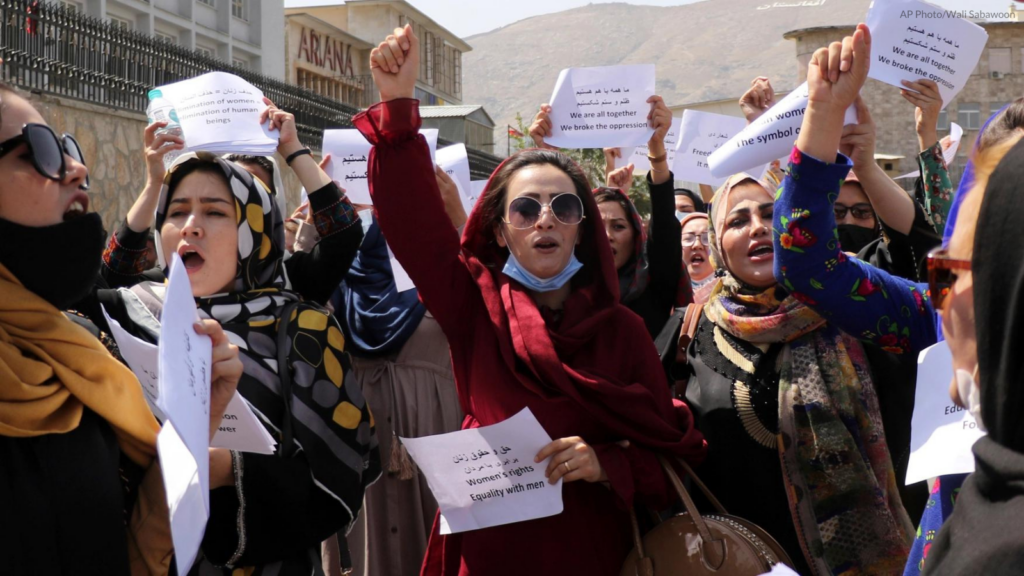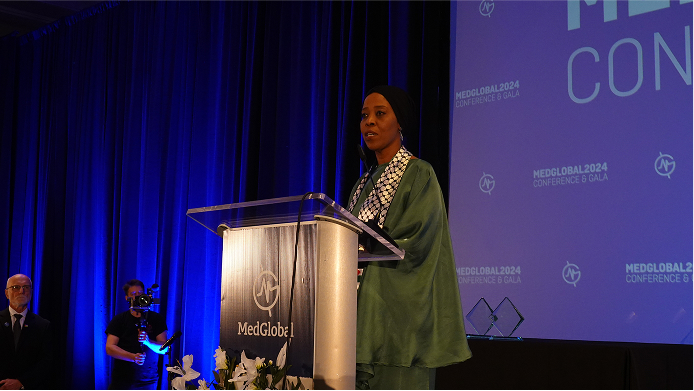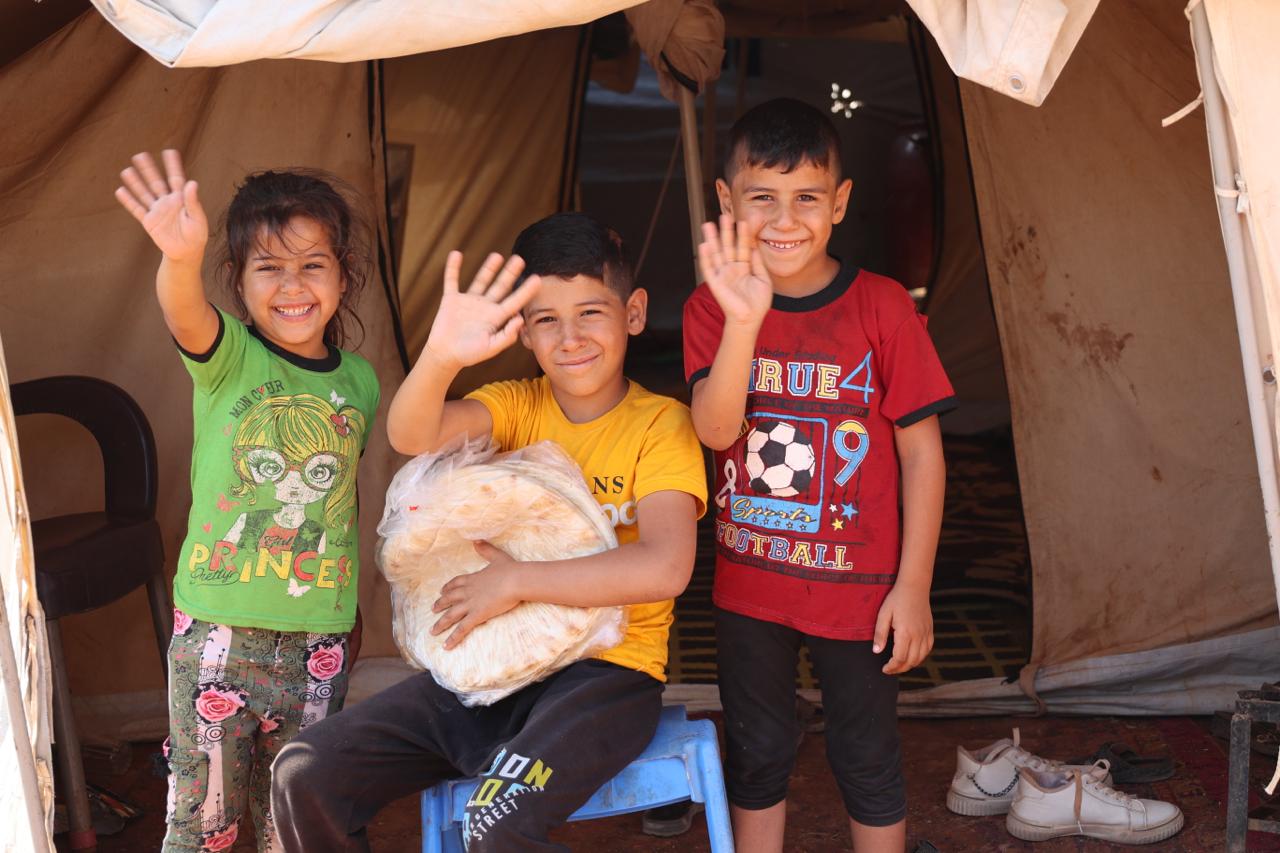Updates & Press
Blog Featured | September 23, 2021
A Pediatrician’s Perspective on the Ongoing Cris
Author | MedGlobalComms

[vc_row][vc_column][vc_column_text]Cover Image: AP Photo/Wali Sabawoon
Dr. Lia Harris, Pediatrician and MedGlobal Volunteer, has been practicing medicine for 20 years. Last year, she travelled to Afghanistan to support Afghan health workers providing care to babies and children of the Helmand province. Hear her perspective on the ongoing humanitarian crisis in Afghanistan, particularly for women and children, and how you can help support those in need:
Afghanistan. The horrific images emerging from the recent takeover of the country by the Taliban, and the resultant chaos are the tip of the iceberg for one of the most severe human rights crises of our times. If men clung to the outside of planes to escape the country, imagine the situation for women and children. I wish to share what I know about women and children in rural Afghanistan.
Working in Afghanistan last year, I watched the tragedy of the crisis unfolding. After decades-long occupation by foreign forces, particularly Russia and USA, the development of an organization like the Taliban was almost certain. Foreign interference created the Taliban. I truly do not fault Afghans for wanting to take back ownership of their own country. Much of the problem, however, is there is no one group which defines Afghanistan, and before foreign occupation they were warring groups. The Taliban is only the most powerful. Make no mistake, the corruption and mistreatment of women and children arose from both government and Taliban sides. In fact, the era of Taliban rule in the late 90s was said to be one of the most peaceful times in Afghanistan, and even while I was there last year, their rule of the districts was fairer and more stable than the government’s. I do not condone the Taliban’s fundamentalist misogyny, but there is no one “bad guy” in the story of Afghanistan. Sadly, the protracted conflict has impacted the vulnerable most severely.
Who suffers? Even before the Taliban came to power, women and children have already suffered most profoundly. During the relatively liberal era in the last 20 years of US-backed government, the majority of women were uneducated, illiterate, forbidden from working, and married young. Women in the region where I was working were not permitted to leave their homes without a male family member accompanying them. Even the educated and relatively emancipated women with whom I worked were too fearful to leave their house without the burka. Birth control is inaccessible and therapeutic abortion illegal. In fact, the culture was such that having numerous children was prized, and women would buy fertility drugs on the market for the purpose of having twins and triplets. With no prenatal care, you can imagine the outcomes. Lack of prenatal care meant maternal mortality is 100x what it is in Canada.
Women could not make their own health decisions; even to undergo an emergency caesarean section, the male family member needed to give approval. Domestic violence is the norm. Victims of rape are killed or shunned by their family. While I was there, on our street, two women who lived independently without a man were killed in their home, and the message from the police was that they deserved it, because they were “unsavory”.
The children also suffer. As a pediatrician, I saw more unnecessary suffering and death in the last year than any Canadian pediatrician would see in multiple careers. The children are not vaccinated; vaccines are believed to be “haram” (forbidden in Islam) by fundamentalist groups (please note, this is not the belief of all Muslims, not even all Afghans, and there is no reference in the Quran or hadith papers). Daily, I saw children dying of tetanus, meningitis, pneumonia, polio, and measles. Southern Afghanistan is one of only two places in the world where polio is not eradicated. The decades-long conflict made any access to the districts too dangerous for health professionals to travel to provide routine vaccines. At worst, the vaccine professionals were targeted and assassinated; 11 were killed while I was there, mostly women.
Children were not only dying from infectious diseases, but starvation, because families could not provide for their many children. They died as casualties of conflict, and because landmines on the road made it too unsafe to travel to our hospital, or from us to a hospital with a higher level of care. Babies died from lack of prenatal care, leading to prematurity, asphyxia, and neonatal infections. Lack of preventive health care and disease was not the only source of childhood suffering; trigger warning for child sexual slavery, look up the term “bacha bazi”.
With new Taliban rule, the future of women and children is uncertain. In some provinces women have already been sent home from their jobs, and universities. In Kabul, Taliban leaders have asked female doctors to stay and continue working. Whatever the outcome, the women of Afghanistan already start from a place of severe oppression.
What can we do? Advocate for the Afghan women and children who truly cannot speak. Yes, petition governments to increase acceptance of refugees, and support their arrival, particularly working Afghan women, journalists, and outspoken women’s rights advocates, but please do not forget those who do not have the privilege of getting here. To become a refugee, you need to be documented, have a passport, and travel to Kabul. This will never happen to the women I met.
For the women who cannot speak for themselves and their children:
- Petition for women’s rights advocates to have a position at the table with the Taliban. Use this time of relative peace to improve the welfare of women.
- Support Amnesty International and other organizations in their human rights advocacy.
- Advocate for the safety of aid organizations to enter the districts, to provide food, health care, vaccines, and WASH (water, sanitation, and hygiene) to the people. See appeals from UNICEF and MSF.
- Promote Afghan women’s voices, in art, music, education, employment, media, sport, and social media. Here are a few Afghan women creatives:
- Shamsia Hassani is the first female graffiti artist of Afghanistan. Through her artworks, Shamsia portrays Afghan women in a male dominant society.
- Sahraa Karimi is an Afghan writer and independent film director.
- Farahnaz Forotan is an Afghan journalist and women’s rights activist.
[/vc_column_text][/vc_column][/vc_row]


